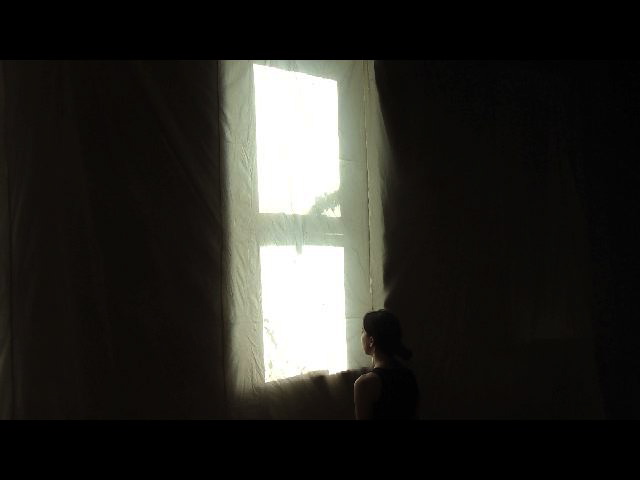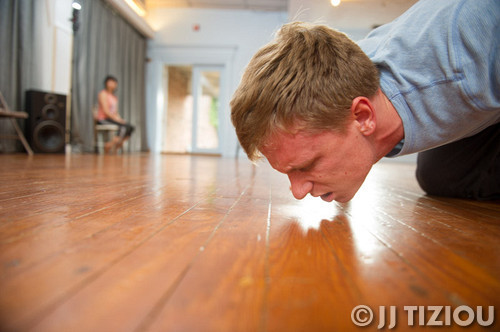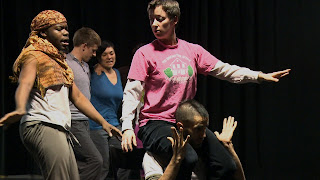June 18th @ 7pm @ LAB space
Notes from workshop #2 with dancers Eun Jung Choi, Jaamil Kosoko, John Luna, Scott McPheeters, Annie Wilsom, Christina Zani
I decided to name this workshop as : Mother and The Architecture of Memory.
I’m trying to find a way to work with and highlight the relationship to memory instead of the memories themselves; To embrace the dialogue between mother and child for instance, not the specific story of each mother and child. Yet the details of each person’s past needs to emerge to support this mission. I’m learning how to include the history of each dancer without weighing too strongly on any one person or event.
I am asking the dancers to trust me with their personal histories. We started with simple details and slowly started digging deeper. I am touched and impressed by their willingness and playfulness.
Embodying Mother
When investigating Mother with the group, I was struck by the visible physical struggle between child and mother as the two attempted to share the same body. As each child attempted to share their body and their mental space with an imagined version of her mother, I was able to identify a vibrant conversation within the body of each performer as they struggled to embody their mother, this person they know so intimately. I realized that I don’t necessarily need to uncover the details of these mothers per se. I am interested in the way their lives interface with the lives of their children. How those children wear that conversation on a daily basis and the ways it lives in their skin.
How “clear” does this experiment need to be? What reads to an unknowing audience? Does a title like Mother give just enough context to frame the performances? These are a few of the questions that arose as I worked with this personal material.
We initially spent some time embracing the archetype of Mother, sliding from image to image, which was a fascinating and chaotic improvisation. At a certain point I asked them to embody their own mother in whatever form that took. Those beings then interacted in a range of ways. Conversations with the dancers and my observations of their improvisations helped me to re-shape the directives and guide the explorations into both potent and playful territory.
Formal exercises. The content of the structure:
We also explored structures that examined the systems at the root of this relationship to the past. These were formal exercises that explored the notion of passing down material, handing down information, and evolution, absorption and the ways we carry something with us. Putting these notions in purely physical terms was really helpful and allowed us to generate material that could augment or sit beside the more emotional, character-driven explorations. The previous blog entry (Blur) outlines one of these experiments.
I am interested in the individual stories of each dancer. But more than that I am interested in their relationship to those stories; how and why they have carried certain details forward with them; and the conversation that occurs between their present and their past when they try to map out (or embody) those details. In organizing these studies into a performance framework I’m faced with choosing the types of memories we display and verbalize as well as the structure we use to convey them.
Through this process I learned that I am primarily interested in examining the tamber of these dancers relationships to their past. I’m curious about the structure of the re-telling; the architecture of the memory.
Here is a video of talking dance structure we are working on. It deals with the “Maps” of space and memory that we carry and accumulate. Again this is something that I was exploring as a solo at first but I enjoy the way it expands with several bodies.
>Video Here< I recently started reading “The Poetics of Space” and its blowing my mind. It relates so pointedly to the various projects that I am working on right now.
Solo Work – the Mother of the process:
My solo practice births and feeds the group explorations. This February workshop came after several months of my solo practice. The group explorations were directly fed by curiosities and concerns that cropped up in my solo research. Figuring out how to bring these ideas to a group of bodies was a fantastic process.
When I embody my own memories and my own mother in the form of a solo it runs the risk of becoming an indulgent work about me and my life.* I don’t necessarily want to make a dance to simply tell you who I am. Instead I am interested in the ways we relate to our past. (And I am my most handy subject on that matter.) I’m curious about the way every moment is getting absorbed and reassimilated; the way our identity is shaped by those moments and our own decisions about what to keep, what to highlight and what to bury. When I bring these concerns to the group I can more easily step back and sculpt both the content and the form.
*Here I am addressing a fear. And a challenge. I am simultaneously pursuing a solo with these themes and ideas. To combat my fear of making of a confessional narrative, my challenge is to balance structure with content, to allow the structure to become the content, to reach past my own circle of experience through acknowledgement of the personal as well as the universal, to embrace the mundane and the epic. Wendy Houstoun is coming to Philadelphia in two weeks to work with me. This will be our first time in the studio together since our intensive in London last June. I look forward to talking further with her about her experience as a solo artist now that I have spent a little time digging around in my own solo practice. I greatly admire her approach to making and performing. Her ability to stay rooted in her own personal narrative while commenting on the culture at large is what drew me to her from the start.
I’ll leave you with a video of the dancers performing a short section that sits somewhere between formal exploration and emotional narrative. A short peek into the beautiful dancers moving and sensing.
I’ve been slowly accumulating a phrase. Well accumulating may be the wrong word because it hasn’t been growing in sequence. Certain movements and moments have been traveling with me since august, determined to remain. Some disappear and resurface. Some things tag along for a while and then drop off for good. Some slowly morph into a new shape
The phrase as a whole is a concise response of sorts, born of my time alone in the studio. At times it is a comfort for me to return to. At other times its a bear I wrestle with. Why are you here? What do you mean? Why don’t you feel the way you did before?
As I spiral off into improvisational exercises, writing assignments and movement tasks, I occasionally check in with my phrase. I bring it new material, gifts for it to reject or absorb.
What am I saying with this phrase? I dare not attempt a summary as its purpose is continually shifting.
Here is a video of the phrase in its current state.
Untitled from Nichole Blog on Vimeo.
(the battery runs out at the end and it cuts off…but the phrase was almost over so its okay…)
I recently used this Franken-phrase as the starting point for a group experiment: I performed it only once for dancer #1 while the others left the room. Her task was to recreate that phrase from memory: to build a repeatable phrase of the same length coming as close to that original phrase as she could come. But instead of simplifying what she could not recall her task was to lie and fabricate the missing details. and to precisely set this new phrase.
Dancer #1 then shows Dancer #2 this new phrase. Only once.
Repeat process for Dancers 3, 4, 5, 6 in a whisper-down-the-lane type process.
In then end we have a 7 fully developed phrases. I am fascinated by: what changes, what persists, what gets dropped immediately and what replaces it. The six phrases sit together like a family portrait of sorts.
Here is a video of the six dancers performing these phrases all together: (they begin in the order in which they saw/created their phrases)
Untitled from Nichole Blog on Vimeo.
Ugliness is just fear.
I took a workshop with John Jaspers a few months ago and he referred to Theodor Adorno’s aesthetic theory, by paraphrasing that the experience of ugliness is directly related to fear. And that beauty only exists as a contrast to ugly; as a response. We used this as a foundation for an exercise. The assignment was to address something we are afraid of and manifest “ugly” in relationship to that. Or more pointedly: dig in a sandbox you don’t like to dig in.
For Jasper’s assignment I listed my fears and chose a few to focus on. (listing your fears in a matter of fact fashion is a worthy exercise on its own. I highly recommend it). I focused on my fears instead of the word ugly. This seemed to be the goal of the exercise and I find it easier to locate the things I fear than to concoct an idea of ugly. It made me realize that I rarely use the term ugly. I placed my voice at the center of the exercise. And combined it with an unpunctuated movement state: un-awkward, non humorous, unpunctuated movement. I drew up a quick study in which the vocalizations and the movements did not respond to one another. They stayed on separate tracks. And when I performed it I realized it actually pointed to another set of fears: non-communication, compartmentalization and repression. We all have long lists of fears. Some we can name easily and some we can’t bear to write down, artistic and personal fears that bleed into one another. I appreciated Jasper’s push for us to create a rigorous artistic response as opposed to a simple confession.
I found this conversation and this assignment interesting.
Beauty/Ugliness is a complicated discussion point often at the center of heated debates: how we each define these things and what we do with the information. But fear is personally palpable.
If we think something is ugly – is it just triggering a fear? I can get behind that theory. When we are searching for beauty are we running from our fears? Maybe but that seems a bit cynical.
So digging in the sandbox of your fears – what does that do? I both loathe and love the challenge of doing so. But I sincerely loved watching the short studies that came from each dancer in the workshop. The dancers performances were -in my opinion- quite beautiful. Beautiful because they showed vulnerability and struggle; they were full of questions that hadn’t been worked out and they were so specific to the individual performing them. And these are things I find quite beautiful.
A few weeks later I had a voice lesson with Mike. My husband is a singer and a voice teacher. Every now and then I ask him for a lesson. “The difference between breathing without sound and breathing with sound is simply the decision to do so. The place where we make that decision (to sing or speak) is the same place in the brain that houses all our memories and all our emotions.”
I’ve never asked him how he learned that, what scientist revealed that or what study proved it. It makes perfect sense to me. I want to believe it and I know that information can really help me.
I’ve always put my body forward with abandon, studying methods of opening and releasing, yearning to perform and be seen, to make dances and share them widely. But I’ve never been quick to speak in public. I’ve learned to move through it as a teacher, but I have some blockades to dismantle as a performer. And my singing hang-ups are specific and raw. I know where they come from but it’s not easy to face it. Singing directly into these memories and these tight areas of my voice has been a fascinating process. On the other hand I do sing freely for my son. He is seven now and I’ve been singing him to sleep every night since his birth. He thinks I have a fantastic voice. To him it’s the sound of love. With him it is uncomplicated.
Several recent experiences are feeding and pointing to the birth of a new voice, or at least new uses for an old voice. For most of my career I’ve been primarily working as a dancer and a silent actor. It’s true I speak in the work of others – namely Headlong Dance Theater – and yes I’ve studied acting a little – but rarely do I speak in my own work and I guarantee I’ve never sung you a song from the stage. And I certainly don’t talk in public about my life experiences. But perhaps that’s changing?
The primal gutterance of water
Theater and Neuroscience project with Dan Rothenberg – November 2011
The voice of my Mother
Women in Comedy project with 1812 productions – August 2011
The events and movements of my past as mixed with Xavier LeRoy’s past
Workshop with choreographer Xavier LeRoy – September 2011
“Diary dates” as prompted by Wendy Houstoun
and the many many wendy exercises – June 2011
Singing through barriers – vocal work with Michael Kiley
Vocal class with my collaborator and husband
P.S. Ideally I will give each of the workshops described above their own post at some point soon

I’ve been rehearsing at Mascher Space co-op in Kensington and I’ve developed a warm connection to the space, a familiarity that affects the rhythm of my time there. Today I walked in and the space was different because it was set up for a performance. Black curtains blocked the mirrors and a white scrim blocked the windows. It was a sunny November day and the shadows against the white scrim created little scenes of shimmering activity. I found them utterly irresistible and spent my session dancing in relationship to this newly designed space.
I spent a long time with this window:
And then I moved on to this one:
For me dance is an art of interaction
Between performers
Between performer and her environment
Between performer and audience
When we take away some of these possible interactions we heighten others. In the same way that when you lose one of your senses the others gain strength and sensitivity.
Alone in the room my relationship to the space itself is heightened. The relationship between my thoughts and my body. The relationship between various parts of my body. These relationships always exist but without audiences, collaborators and designers new connections are fore-grounded.
this title was stirring in my brain in the wee hours of the night. and it was halloween night i should note.
i grew up on midway avenue. and when i visit this space in my mind it is crammed full of memories. Most of them are mine but many are intruders: imagined scenes from books, movies and news stories have been staged there by my subconscious… they needed a space to unfold so i placed them in the rooms of midway avenue.
as i tour the space my own memories co-mingle with characters from novels, the gory remains from a script, or accumulated information about a friend’s past. it can become difficult to parce out what is mine and what is borrowed.
midway avenue is the memory map i’m using for a structural exercise i’m exploring in my solo practice. And each time I visit I find something new.
And the title I really like is this:
Midway Avenue and the Haunted House of Indecision.

















